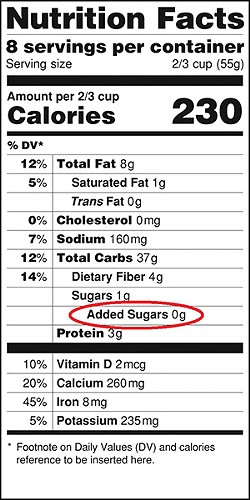Sweet defeat
How sugar hides in plain sight
[
{
"name": "Air - MedRect Combo - Inline Content 1",
"component": "11490391",
"insertPoint": "3",
"requiredCountToDisplay": "1",
"parentWrapperClass": "fdn-ads-inline-content-block"
},{
"name": "Air - MedRect Combo - Inline Content 2",
"component": "11490392",
"insertPoint": "7",
"requiredCountToDisplay": "5",
"parentWrapperClass": "fdn-ads-inline-content-block"
},{
"name": "Air - MedRect Combo - Inline Content 3",
"component": "11490393",
"insertPoint": "12",
"requiredCountToDisplay": "9",
"parentWrapperClass": "fdn-ads-inline-content-block"
}
]
Trembling, I sat in my car outside a pharmacy. I struggled internally over whether to go inside. I walked in, picked up an item, set it on the counter and waited impatiently for the clerk to come around. The item: a candy bar. I am a sugar addict.
Numerous studies have shown that sugar affects the brain in ways similar to cocaine. It’s been tied to everything from obesity to heart disease to diabetes. And both sugar and artificial sweeteners stimulate the appetite rather than satisfy it. Fortunately for me, I know I have a problem. Otherwise I might have eaten the whole bar rather than just enough to get my head right. Of course, part of the problem might have been that I had gone a while without eating sugar-laced foods, which was no easy task.
Virtually every item on grocery store shelves has added sugar, even items you wouldn’t typically think of as sweet. Ketchup, barbecue sauce and mayonnaise usually have sugar added, as do most types of bread. Yogurt, if it has any flavoring to it, has extra sugar, and it’s usually marketed as a health food.
It gets tricky when you start looking at pasta sauce or dairy products. Those have naturally occurring sugars, which are less harmful because they are tied to fiber and nutrients. You have to read the ingredient list to even know the refined sugars are there, and they have so many names: honey, agave nectar, concentrated fruit juice, sucrose, glucose, fructose, dextrose (most things that end in –ose, really) and of course high-fructose corn syrup.
Nutrition labels won’t tell you how much of the sugar is natural versus how much was added. But that could soon change. The U.S. Food and Drug Administration is considering a new design for nutrition labels, which would require “added sugars” to be listed under the total sugar in the food, among other changes. The new design would also remove “calories from fat” from the label, which might not be a huge loss.
“So much of the emphasis for treating obesity, for treating heart disease, is to lower the fat content of the diet along with the salt,” said Dr. Craig Backs, a Springfield physician who emphasizes wellness and prevention before having to treat a disease.
“It wasn’t until more recently that you see more and more discussion about the role of sugar and the sort of hidden sources of sugar in our American diet,” Backs said.
A few years ago, Backs took part in a program aimed at getting health professionals in shape. It was called “Doctors and Nurses Get Fit,” and it involved both dietary changes and a fitness regimen.
“The diet? Pretty simple: don’t eat any sugar,” Backs said. “And oh, by the way, there’s sugar in just about everything.”
That may seem pretty hopeless for anyone trying to avoid sugar. But Backs says there’s a pretty easy rule of thumb: stick to the perimeter of the grocery store. That’s usually where the fresh, unprocessed foods like fruits and vegetables are stocked. He also says it’s a good idea to be skeptical of foods labeled “low-fat.”
“Fat is flavorful, so if they take the fat out, they have to replace the flavor with something else to make up for it,” Backs said. “It tends to be replaced with sugar.”
The American Heart Association recommends a maximum of 6 teaspoons of sugar a day for women, (that’s about 30 grams) and 9 teaspoons for men (45 grams). A 12-ounce soft drink contains anywhere from 39 to 47 grams of sugar, while a sports drink of the same size generally has about 21 grams. Twelve ounces of orange juice contains 33 grams of sugar, and that sugar isn’t any better than the sugar in a soft drink. Without the fibrous pulp of the solid fruit, it’s all just sugar.
As for me, the battle continues. I can’t always fend off the cravings. Sometimes I can’t focus unless I’ve had something sweet. But I look at a piece of candy the same way a smoker would a cigarette: I know it’s bad for me and I’m trying to quit, but it’s going to take some time. It may not taste like victory, but it’s a step in the right direction.
Contact Alan Kozeluh at [email protected].
Numerous studies have shown that sugar affects the brain in ways similar to cocaine. It’s been tied to everything from obesity to heart disease to diabetes. And both sugar and artificial sweeteners stimulate the appetite rather than satisfy it. Fortunately for me, I know I have a problem. Otherwise I might have eaten the whole bar rather than just enough to get my head right. Of course, part of the problem might have been that I had gone a while without eating sugar-laced foods, which was no easy task.
Virtually every item on grocery store shelves has added sugar, even items you wouldn’t typically think of as sweet. Ketchup, barbecue sauce and mayonnaise usually have sugar added, as do most types of bread. Yogurt, if it has any flavoring to it, has extra sugar, and it’s usually marketed as a health food.
It gets tricky when you start looking at pasta sauce or dairy products. Those have naturally occurring sugars, which are less harmful because they are tied to fiber and nutrients. You have to read the ingredient list to even know the refined sugars are there, and they have so many names: honey, agave nectar, concentrated fruit juice, sucrose, glucose, fructose, dextrose (most things that end in –ose, really) and of course high-fructose corn syrup.
Nutrition labels won’t tell you how much of the sugar is natural versus how much was added. But that could soon change. The U.S. Food and Drug Administration is considering a new design for nutrition labels, which would require “added sugars” to be listed under the total sugar in the food, among other changes. The new design would also remove “calories from fat” from the label, which might not be a huge loss.
“So much of the emphasis for treating obesity, for treating heart disease, is to lower the fat content of the diet along with the salt,” said Dr. Craig Backs, a Springfield physician who emphasizes wellness and prevention before having to treat a disease.
“It wasn’t until more recently that you see more and more discussion about the role of sugar and the sort of hidden sources of sugar in our American diet,” Backs said.
A few years ago, Backs took part in a program aimed at getting health professionals in shape. It was called “Doctors and Nurses Get Fit,” and it involved both dietary changes and a fitness regimen.
“The diet? Pretty simple: don’t eat any sugar,” Backs said. “And oh, by the way, there’s sugar in just about everything.”
That may seem pretty hopeless for anyone trying to avoid sugar. But Backs says there’s a pretty easy rule of thumb: stick to the perimeter of the grocery store. That’s usually where the fresh, unprocessed foods like fruits and vegetables are stocked. He also says it’s a good idea to be skeptical of foods labeled “low-fat.”
“Fat is flavorful, so if they take the fat out, they have to replace the flavor with something else to make up for it,” Backs said. “It tends to be replaced with sugar.”
The American Heart Association recommends a maximum of 6 teaspoons of sugar a day for women, (that’s about 30 grams) and 9 teaspoons for men (45 grams). A 12-ounce soft drink contains anywhere from 39 to 47 grams of sugar, while a sports drink of the same size generally has about 21 grams. Twelve ounces of orange juice contains 33 grams of sugar, and that sugar isn’t any better than the sugar in a soft drink. Without the fibrous pulp of the solid fruit, it’s all just sugar.
As for me, the battle continues. I can’t always fend off the cravings. Sometimes I can’t focus unless I’ve had something sweet. But I look at a piece of candy the same way a smoker would a cigarette: I know it’s bad for me and I’m trying to quit, but it’s going to take some time. It may not taste like victory, but it’s a step in the right direction.
Contact Alan Kozeluh at [email protected].
Illinois Times has provided readers with independent journalism for almost 50 years, from news and politics to arts and culture.
Your support will help cover the costs of editorial content published each week. Without local news organizations, we would be less informed about the issues that affect our community..
Got something to say?
Send a letter to the editor and we'll publish your feedback in print!




















